Cranes and hoists
- Boom type elevating work platform - WP
- Bridge and gantry crane - CB
- Vehicle loading crane - CV
- Non-slewing mobile crane - CN
- Slewing mobile crane - C2, C6, C1, C0
- Derrick crane - CD
- Portal boom crane - CP
- Tower crane - CT
- Self erecting tower crane - CS
- Materials hoist - HM
- Personnel and materials hoist - HP
- Concrete placing boom - PB
- Reach stacker - RS
Boom type elevating work platform - WP

The scope for this licence covers the operation of all boom-type elevating work platforms.
An elevating work platform is either a telescoping device, hinged device, articulated device or any combination of these used to support a platform on which personnel, equipment or materials may be elevated to perform work and where the boom length is 11 metres or more.
You do not require a licence if the boom length is less than 11 metres. The length of the boom is the greater of the following:
- The vertical distance from the surface supporting the boom-type elevating work platform to the floor of the platform with the platform extended to its maximum height.
- The horizontal distance from the centre point of the boom’s rotation to the outer edge of the platform with the platform extended to its maximum distance
A WP HRW licence is required when operating a telehandler, also known as a multi tool carrier, that is fitted with a personnel box with operating controls in the box and the boom length is 11 metres or more.
download Boom type elevating work platform (PDF, 81.1 KB)
Bridge and gantry crane - CB
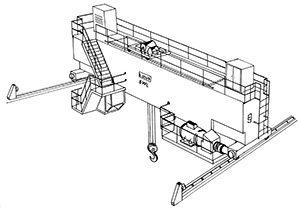
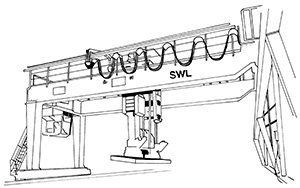
The scope for this licence class covers the operation of all bridge and gantry cranes.
A bridge crane consists of a bridge beam or beams mounted to an end carriage at each end, and is capable of travelling along elevated runways and having one or more hoisting mechanisms arranged to traverse across the bridge.
A gantry crane consists of a bridge beam supported at each end by legs mounted on end carriages, capable of travelling on supporting surfaces or deck levels, whether fixed or not, including a crab with one or more hoisting units arranged to travel across the bridge.
A licence is required if the bridge or gantry crane is controlled from a permanent cabin or control station on the crane or is remotely controlled and having more than 3 powered operations. This includes the application of load estimation and slinging techniques to move a load.
download Bridge and gantry crane (PDF, 100.5 KB)
Vehicle loading crane - CV
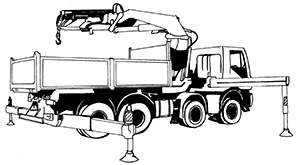
The scope for this licence class covers the operation of all vehicle loading cranes with a capacity of ten metre tonnes or more including the application of load estimation and slinging techniques to move a load.
A vehicle loading crane is a crane mounted on a vehicle for the purpose of loading and unloading the vehicle. You may also operate a vehicle loading crane if you hold a slewing mobile crane operation licence.
Ten metre tonnes
For vehicle loading cranes (CV) that have a capacity of 10.0 metre tonnes or greater, the operator must have a HRW licence.
For operators of vehicle loading cranes where the maximum working load of the crane is less than 10 metre tonnes, the operator does not require a HRW licence. The operator is to be adequately trained to ensure they are competent to operate the crane.
The measurement of metre tonnes is obtained by multiplying the maximum mass that may be lifted at the particular slewing radius. This information is to be taken from the load chart which must be affixed to the crane in view of the operator.
It will only require one lifting capacity of 10.0 metre tonnes and over for the operator to be required to hold a HRW licence.
Example 1
With a jib fully extended at 12.0 metres, a vehicle crane can lift 850kg.
12.0 metres X 0.85 tonnes = 10.2 metre tonnes
A HRW licence is required to operate the crane, irrespective of any other lifting options on the load chart.
Example 2
With a jib fully retracted, another vehicle crane at 3.0 metres reach can lift 3250 kg.
3.0 metres X 3.25 tonnes = 9.75 metre tonnes
Check if any other lifting options fall within the licence requirement; if not, a HRW licence is not required to operate the crane, but the operator must be trained to be able to operate competently.
Example 3
With the jib half extended at 4.5 metres, a vehicle crane can lift 2550kg.
- metres X 2.55 tonnes = 11.475 metre tonnes
A HRW licence is required to operate the crane, irrespective of any other lifting options on the load chart.
download Vehicle loading crane (PDF, 69.2 KB)
Non-slewing mobile crane - CN
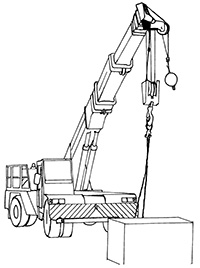
The scope for this licence is for the operation of a non-slewing mobile crane with a capacity greater than 3 tonnes.
A non-slewing mobile crane is a powered mobile crane that incorporates a boom or jib which does not slew and includes an articulated mobile crane or a locomotive crane but excludes a crane engaged in vehicle tow truck operation.
If you hold a slewing mobile crane operation licence you may also operate a non-slewing mobile crane.
download Non-slewing mobile crane (PDF, 64.8 KB)
Slewing mobile crane - C0, C1, C2, C6
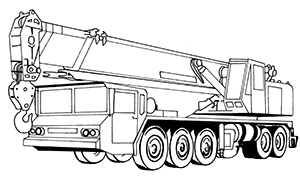
Slewing mobile cranes are mobile cranes incorporating a boom or jib that can be slewed. It excludes a front- end loader, a backhoe, an excavator or other earthmoving equipment when configured for crane operation. The licence class encompasses the requirement for the non-slewing mobile crane operation licence, the vehicle loading crane operation licence and reachstacker.
A slewing mobile crane HRW licence is required when operating a telehandler that is fitted with a jib or used as a crane of any description. The slewing mobile crane licence would be relevant to the rated capacity of the telehandler.
Slewing mobile crane with a capacity up to 20 tonnes – C2
The scope for this licence class covers the operation of slewing mobile cranes with a capacity up to 20 tonnes.
Slewing mobile crane with a capacity up to 60 tonnes – C6
The scope for this licence class covers the operation of slewing mobile cranes with a capacity up to 60 tonnes.
Slewing mobile crane – with a capacity up to 100 tonnes – C1
The scope for this licence class covers the operation of slewing mobile cranes with a capacity up to 100 tonnes.
Slewing mobile crane – with a capacity over 100 tonnes – C0
The scope for this licence class covers the operation of slewing mobile cranes of any capacity.
download Slewing mobile crane (PDF, 120.2 KB)
Derrick crane - CD
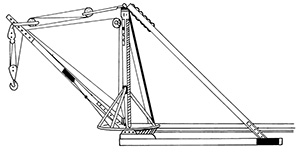
The scope for this licence class covers the operation of all derrick cranes.
A derrick crane means a slewing strut-boom crane with its boom pivoted at the base of a mast which is either guyed (guy-derrick) or held by backstays (stiff-leg derrick) and which is capable of luffing under load.
download Derrick crane (PDF, 86.3 KB)
Portal boom crane - CP
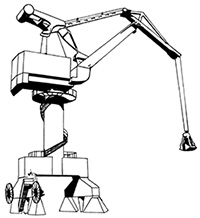
The scope of this licence class covers the operation of all portal boom cranes.
A portal boom crane means a boom crane or jib crane that is mounted on a portal frame that, in turn, is supported on runways along which the crane travels.
download Portal boom crane (PDF, 78.1 KB)
Tower crane - CT
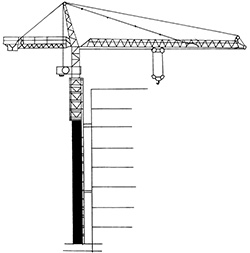
The scope for this licence class covers the operation of all tower cranes.
Tower crane means a boom crane or a jib crane mounted on a tower structure. Also the crane, if a jib crane, may be horizontal or luffing jib type and the tower structure may be demountable or permanent, but does not include a self-erecting tower crane.
Tower cranes are fixed to the ground on a concrete slab (and sometimes attached to the sides of structures). Tower cranes often give the best combination of height and lifting capacity and are used in the construction of tall buildings. The base is then attached to the mast which gives the crane its height. The mast is attached to the slewing unit (gear and motor) that allows the crane to rotate. On top of the slewing unit there are three main parts which are: the long horizontal jib (working arm), shorter counter-jib, and the operators cab.
The long horizontal jib is the part of the crane that carries the load. The counter-jib carries a counterweight, usually of concrete blocks, while the jib suspends the load to and from the centre of the crane. The crane operator either sits in a cab at the top of the tower or controls the crane by radio remote control from the ground.
download Tower crane (PDF, 206.5 KB)
Self erecting tower crane - CS
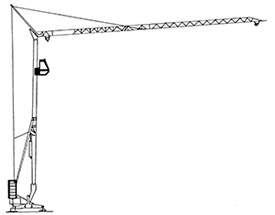
The scope for this licence class covers the operation of all self-erecting tower cranes.
Self-erecting tower crane means a crane that is not disassembled into a tower element and a boom or jib element in the normal course of use and where the erection and dismantling processes are an inherent part of the crane’s function
Self-erecting tower cranes lift themselves from the ground or lift an upper, telescoping section using jacks, allowing the next section of the tower to be inserted at ground level or lifted into place by the partially erected crane. Therefore they can be assembled without outside help, and can grow together with the building or structure they are erecting.
download Self erecting tower crane (PDF, 49.1 KB)
Materials hoist - HM
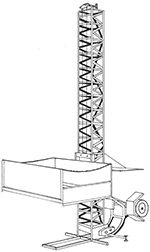
The scope for this licence class covers the operation of materials platform hoists.
A materials hoist means a hoist that consists of a car, bucket or platform cantilevered from, and travelling up and down outside, a face of the support structure and is used for hoisting things and substances but not persons. Also known as a builders hoist.
Material hoists may also be operated by anyone holding a personnel and materials hoist HRW licence.
download Materials hoist (PDF, 85.0 KB)
Personnel and materials hoist - HP
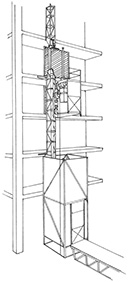
A materials or personnel hoist is a cantilevered hoist, a tower hoist or several winches configured to operate as a hoist and is intended to carry goods, materials or people.
It excludes a mast climber, building maintenance unit, suspending scaffold, jump form or slip form.
This licence encompasses the requires for the material hoist (cantilever platform operation licence).
download Personnel and materials hoist (PDF, 86.1 KB)
Concrete placing boom - PB
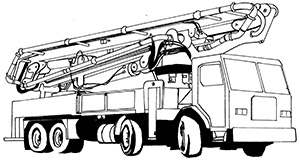
A concrete placing boom incorporates a knuckle boom, capable of power operated slewing and luffing to place concrete by way of pumping through a pipeline attached to, or forming part of, the boom of the plant.
This includes both vehicle mounted and satellite concrete placing booms.
download Concrete placing boom (PDF, 101.5 KB)
Reach stacker - RS
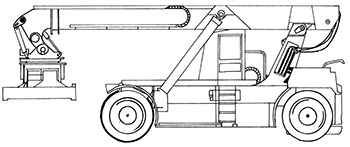
The reach stacker licence covers powered reach stackers of greater than three tonne capacity that incorporate an attachment for lifting, lowering, moving and travelling with a shipping container.
This does not include a portainer crane.
download Reach stacker (PDF, 79.6 KB)
Dogging and rigging operation
Dogging - DG
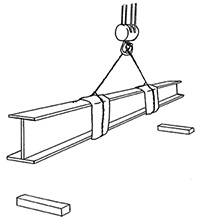
For the purposes of licensing, dogging work means the application of slinging techniques, including selection and/or inspection of lifting gear to safely sling a load or directing plant operator in the movement of a load when the load is out of the operator’s view.
Slinging technique means the exercising of judgement in relation to the suitability and condition of lifting gear and the method of slinging, by consideration of the nature of the load, its mass and its centre of gravity.
You do not require a licence if you are slinging loads that don’t involve slinging techniques, and the load remains in the clear view of the plant operator and there is no requirement to exercise judgement about:
- which sling to use
- how to sling the load
- the condition of the sling or load and its centre of gravity
You can carry out dogging work if you hold a basic, intermediate or advanced rigging licence.
download Dogging (PDF, 42.0 KB)
Basic rigging - RB
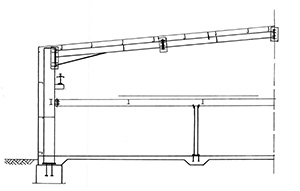
For the purposes of licensing, rigging work means the use of mechanical load shifting equipment and associated gear to move, place or secure a load including plant, equipment or members of a structure to ensure the stability of those members. It also includes the setting up and dismantling of cranes and hoists.
The scope of work for basic rigging includes:
- dogging work
- structural steel erection
- particular hoists
- pre-cast concrete members of a structure
- safety nets and static lines
- mast climbing work platforms
- perimeter safety screens and shutters
- cantilevered crane loading platforms
It is a prerequisite that applicants for the basic rigging licence already hold or have previously passed assessment for a dogging licence or alternatively assessment for the applicants must incorporate the requirements for dogging assessments.
You can erect and dismantle safety nets and static lines if you hold a basic scaffolding licence.
You can erect and dismantle cantilevered crane loading platforms and mast climbers if you hold an intermediate scaffolding licence or equivalent.
download Basic rigging (PDF, 60.6 KB)
Intermediate rigging - RI
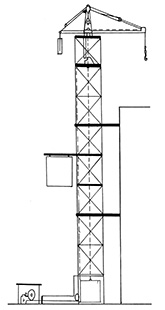
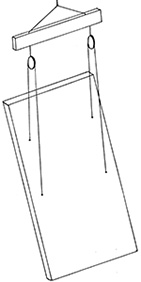
equaliser gear
The scope of work for intermediate rigging includes:
- rigging work in the class Basic Rigging
- hoists with jibs and self-climbing hoists
- rigging of cranes, conveyors, dredges and excavators
- tilt-slabs
- demolition of structures or plant
- dual lifts
It is a prerequisite that applicants for the intermediate rigging licence already hold or have previously passed assessment for a dogging and basic rigging licence. Alternatively, assessment for applicants for the intermediate licence must incorporate the requirements of dogging and basic rigging licence assessments.
You do not require a licence if you are positioning integral outriggers or stabilisers to set up a crane or hoist.
download Intermediate rigging (PDF, 129.2 KB)
Advanced rigging - RA
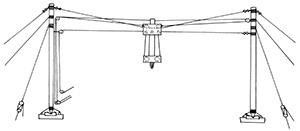
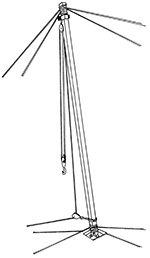
The scope of work for advanced rigging includes:
- rigging work in the class Intermediate Rigging
- rigging of gin poles and shear legs
- flying foxes and cableways
- guyed derricks and structures
- suspended scaffolds and fabricated hung scaffolds
It is a prerequisite that applicants for the advanced rigging licence already hold or have previously passed assessment for a dogging, basic and intermediate rigging licence.
You do not require a licence if you are positioning integral outriggers or stabilisers to set up a crane or hoist.
You can erect and dismantle suspended scaffolds and hung scaffolds if you hold an advanced scaffolding licence or equivalent.
You require the intermediate scaffolding licence or equivalent if you are erecting or dismantling tube and coupler suspension rigs for suspended scaffolds.
download Advanced rigging (PDF, 75.5 KB)
Scaffolding operation
Basic scaffolding - SB
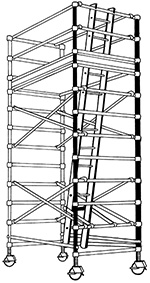
(tower frame type)
For the purpose of licensing, scaffolding work means erecting, altering or dismantling a temporary structure that is or has been erected to support a platform and from which a person or object could fall more than 4 metres from the platform or the structure.
The scope of work for a basic scaffolding licence includes:
- modular or prefabricated scaffolds
- cantilevered materials hoist with a maximum working load of 500 kg (materials only)
- ropes
- gin wheels
- safety nets and static lines
- bracket scaffolds (tank and formwork)
You can erect and dismantle safety nets and static lines if you hold the basic rigging licence.
download Basic scaffolding (PDF, 126.2 KB)
Intermediate scaffolding - SI
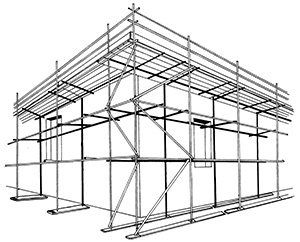
The scope of work for intermediate scaffolding includes:
- scaffolding work included in the class of Basic Scaffolding
- tube and coupler scaffolds including tube and coupler covered ways and gantries
- cantilever crane loading platforms
- cantilever and spurred scaffolds
- barrow ramps and sloping platforms
- scaffolding associated with perimeter safety screens and shutters
- mast climbing work platforms
It is a prerequisite that applicants for an intermediate scaffolding licence already hold or have passed assessment for a basic scaffolding licence or alternatively assessment for the applicants must incorporate the requirements for basic scaffolding assessments.
You can erect and dismantle cantilevered crane loading bays and mast climbers if you hold the basic rigging licence or equivalent.
download Intermediate scaffolding (PDF, 112.9 KB)
Advanced scaffolding - SA
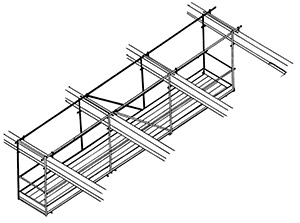
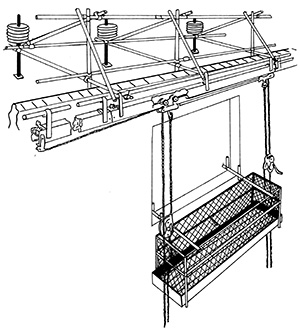
The scope of work for advanced scaffolding includes:
- scaffolding work included in the Intermediate scaffolding class
- cantilevered hoists
- hung scaffolds, including scaffolds hanging from tubes, wire ropes or chains
- suspended scaffolds
It is a prerequisite that applicants for an advanced scaffolding licence already hold or have previously passed assessment for a basic and intermediate scaffolding licence or alternatively assessment for the applicants must incorporate the requirements for intermediate scaffolding assessments.
You can erect and dismantle cantilevered hoists (no restrictions) if you hold an intermediate rigging licence or equivalent.
You can erect and dismantle hung scaffolds that are fully fabricated if you hold the advanced rigging licence or equivalent.
You can erect and dismantle suspended scaffolds if you hold the advanced rigging licence provided that, where the scaffold incorporated is a tube and coupler suspension, rig, an intermediate scaffolding licence of equivalent is also held.
download Advanced scaffolding (PDF, 123.8 KB)
Forklift operation
Forklift truck - LF
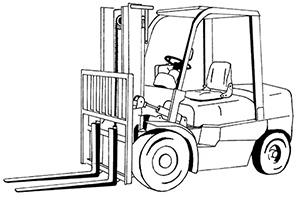
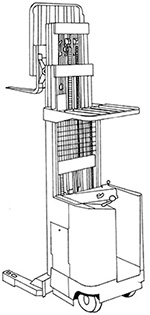
(non-counter balanced type)
The scope for this licence class covers the operation of forklift trucks.
A forklift truck is a powered industrial truck equipped with lifting media made up of a mast and an elevating load carriage to which is attached a pair of fork arms or other arms that can be raised 900mm or more above the ground but does not include a pedestrian-operated truck or a pallet truck.
Forklift trucks are used to lift and transport materials and can be powered by electric motors or internal combustion engines running on petrol, diesel or LPG fuels.
This licence class does not include order-picking forklift trucks.
download Forklift truck (PDF, 123.7 KB)
Order picking forklift truck - LO
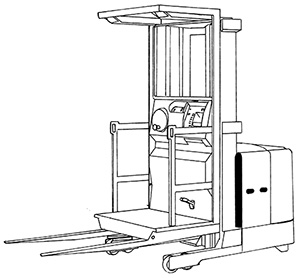
The scope for this licence class covers the operation of order-picking forklift trucks.
An order-picking forklift truck is a type of forklift truck where the operator’s control is incorporated with the load carriage/lifting media and elevates with it.
Order-picking forklift trucks can be fitted with a platform extension for use in furniture warehouses, or can be a turret truck in narrow aisle warehouses.
This licence does not cover the operation of non order-picking forklift trucks.
download Order picking forklift truck (PDF, 67.6 KB)
Operating forklifts on public roads
If you operate and/or drive a forklift truck on any area open to the public (for example, any road, carpark), then you must have a current car driver’s licence and a HRW licence.
For more information on operating a forklift on any area open to the public call the Department of State Growth on 1300 135 513.
Pressure equipment
- Boiler standard - BS
- Boiler advanced - BA
- Reciprocating steam engine operation - ES
- Turbine operation - TO
Boiler standard - BS
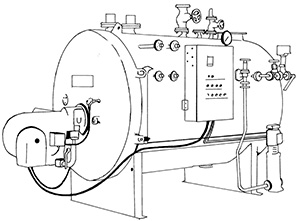
This licence class includes the operation of a boiler with a single fuel source that does not have a pre-heater, superheater or economiser attached.
This does not include:
- Fully flooded or pressurized system where water or another liquid is heated to a temperature lower than the normal atmospheric boiling temperature of the liquid;
- A direct fired process heater;
- Boilers with less than 5 square metres heating surface or 150 kilowatt output;
- Unattended boilers certified in compliance with AS2593:2004
download Boiler standard (PDF, 85.6 KB)
Boiler advanced - BA
The scope of work for advanced boiler operation includes the operation of a boiler, including a standard boiler, which may have one or more of the following:
- multiple fuel sources
- pre-heater
- superheater
- economiser
Reciprocating steam engine operation - ES
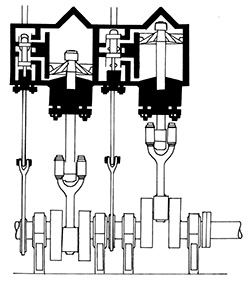
Reciprocating steam engine means equipment that is driven by steam acting on piston causing the piston to move, and includes an expanding (steam) reciprocating engine.
This includes all expanding (steam) reciprocating engines and reciprocating steam engines with any piston diameter of greater than 250 millimetres.
download Reciprocating steam engine operation (PDF, 77.3 KB)
Turbine operation - TO
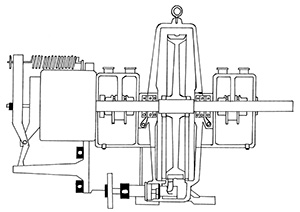
The class includes the operation of a turbine that has an output of 500kW or more and includes one of the following:
- multi-wheeled
- capable of a speed greater than 3600 revolutions per minute
- has attached condensers
- has a multi-staged heat exchange extraction process
A turbine means equipment that is driven by steam acting on a turbine or rotor to cause a rotary motion.
download Turbine operation (PDF, 98.0 KB)
Boiler features explained
Multiple fuel source
This is a term applied to a boiler, which is designed to burn multiple types of fuels in its operation. A boiler operator would require an advanced endorsement when the operation relies on multiple fuel types that may be fired simultaneously. This does not include boilers that change fuel type during start sequence. A boiler that relies on multiple fuel types means a boiler that is fired using at least two of the following fuel types:
- gas
- liquid fuel, including oil and diesel fuel
- solid fuel, including coal (including pulverised coal), briquettes, coke, wood (including wood chips) or any other type of solid fuel.
Pre-heaters
The purpose of a preheater is to recover lost heat from the boiler flue gas which increases the thermal efficiency of the boiler by reducing the useful heat lost in the flue gas. As a consequence, the flue gases are also conveyed to the flue gas stack (or chimney) at a lower temperature, allowing simplified design of the conveyance system and the flue gas stack. It also allows control over the temperature of gases leaving the stack to meet emissions requirement. Pre-heaters have not been defined but have generally been considered as large plant with air pre-heaters only, as opposed to small plant with feedwater heaters as many small plants will have simple feedwater pre-heaters. Pre-heaters should be limited to air and steam re-heaters for multi stage steam heating arrangements but exclude feedwater pre-heaters.
Superheater
A superheater is a device used to convert saturated steam or wet steam into dry steam used in steam engines or in processes, such as steam reforming. There are three types of superheaters namely: radiant, convection, and separately fired. A superheater can vary in size from a few metres or some hundred metres. In a steam engine, the superheater re-heats the steam generated by the boiler, increasing its thermal energy and decreasing the likelihood that it will condense inside the engine. Steam which has been superheated
is logically known as superheated steam; non-superheated steam is called saturated steam or wet steam. Superheaters were applied to steam locomotives in quantity from the early 20th century, to most steam vehicles, and to stationary steam engines.
Economiser
In boilers, economisers are basically heat exchange devices that heat fluids, usually water, up to but not normally beyond the boiling point of that fluid. Economisers are so named because they can make use of the heat energy in fluid streams that are hot, but not hot enough to be used in a boiler, thereby recovering more useful heat energy and improving the boiler’s efficiency.
Multi tool carrier / Telehandler
A multi tool carrier (also known as a variable reach truck, multi-purpose tool carrier or telehandler) can be fitted with a range of attachments that include hydraulic winch, hoisting block and hook, bucket, jib, bucket with grab, grab, earthmoving blade, concrete skip, earthmoving hoe, forks, elevating work platform, tyre handler.
Typically, multi tool carriers are used to travel with their load. When the load is supported on forks, it should be lowered as close to the ground as possible and the boom retracted during travel.
However, when the load is freely suspended, it needs to be elevated to prevent it snagging on the ground or other obstacles. The stability of the multi tool carrier may adversely be affected as the load can swing and exert additional dynamic forces. When operating on sloping ground, the potential for instability is increased, as the load will swing further from the point where it is connected to the multi tool carrier.
Operators of multi tool carriers must hold an appropriate class of license for the work performed and attachments used in addition to the training requirements listed in the table listed below.
| Attachment fitted | Licence class |
|---|---|
| When multi tool carrier is non-slewing and fitted with a jib or used as a crane with a rated capacity of 3 tonnes or less | No licence is required by the legislation. |
| When multi tool carrier is non-slewing and fitted with a jib or used as a crane with a rated capacity greater than 3 tonnes | Operators must hold a non-slewing mobile crane licence (CN) |
| When slewing and fitted with a jib or used as a crane of any description | Operators must hold a slewing mobile crane Licence appropriate for the rated capacity (for example a C2 licence allows for a rated capacity up to 20 t) |
| When machine is fitted with forks and similar attachments | No licence is required by the legislation |
| When machine is fitted with a loader bucket | No licence is specified by legislation |
| When machine is fitted with a boom-type elevating work platform greater than 11 metres | Operators must hold a boom-type elevating work platform Licence (code WP) |
